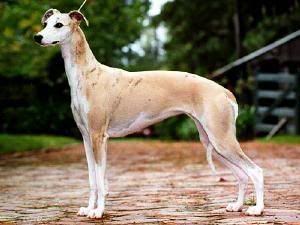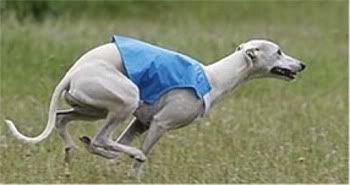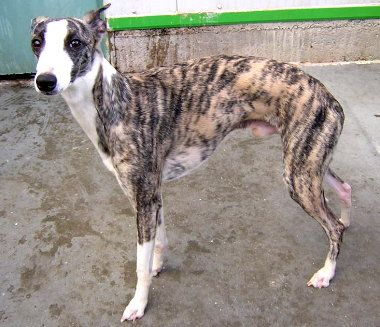Post by charmingnancy on Mar 9, 2009 15:19:13 GMT -5
Whippet
Group: 2- Hounds
Origin: England
Purpose: Bred to hunt by sight, coursing game in open areas at high speeds

Description:
The Whippet is a breed of dog, specifically a member of the sighthound family. They are active and playful and are physically similar to a small greyhound. The Whippet should be a dog of moderate size, very alert, that can cover a maximum of distance with a minimum of lost motion, a true sporting hound. Should be put down in hard condition but with no suggestion of being muscle-bound.
Appearance- Breed Standards:
Coat and Colour: Coat close, smooth and firm in texture. Colour immaterial.
Head: Long and lean, fairly wide between the ears, scarcely perceptible stop, good length of muzzle which should be powerful without being coarse. Nose entirely black. Teeth white, strong and even. Teeth of upper jaw should fit closely over the lower. Eyes large, intelligent, round in shape and dark hazel in colour, must be at least as dark as the coat colour. Expression should be keen and alert. A sulky expression and lack of alertness to be considered most undesirable. Ears are small, fine in texture, thrown back and folded. Semi-pricked when at attention.
Neck: Long and muscular, well arched and with no suggestion of throatiness, widening gradually into the shoulders. Must not have any tendency to an "ewe" neck.
Forequarters: Shoulders long, well laid back with long, flat muscles. Forelegs straight and rather long, held in line with the shoulders and not set under the body so as to make a forechest. Elbows should turn neither in nor out and move freely with the point of the shoulder. Fair amount of bone, which should carry right down to the feet. Pasterns strong.
Body: Back strong and powerful, rather long with a good, natural arch over the loin creating a definite tuck-up of the underline, but covering a lot of ground. Brisket very deep and strong, reaching as nearly as possible to the point of the elbow. Ribs well sprung but with no suggestion of barrel shape. Should fill in the space between the forelegs so that there is no appearance of a hollow between them.
Hindquarters: Long and powerful, stifles well bent, hocks well let down and close to the ground. Thighs broad and muscular, the muscles should be long and flat. A steep croup is most undesirable. Feet must be well formed with strong, thick pads and well-knuckled up paws.
Tail: Long and tapering, should reach to a hip bone when drawn through between the hind legs. Must not be carried higher than the top of the back when moving.
Gait: Low, free moving and smooth, as long as is commensurate with the size of the dog.
Faults: Light yellow or oblique eyes should be strictly penalized. Gay ears are incorrect and should be severely penalized. Loaded shoulders are a very serious fault. A thin, flat open foot is a serious fault. A short mincing gait with high knee action should be severely penalized.
Disqualifications: Undershot mouth and any coat other than that described in the standard.
Size:
Ideal height for dogs 19 - 22 inches; for bitches, 18 - 21 inches. These are not intended to be definite limits, only approximate.

Temperament:
Whippets are lively and alert but not in the least high strung. They are a very versatile breed that can run, play and then be a couch potato 10 minutes later. Whippets are very attached to their people and those they love. They are truly a great companion and prefer not to be left alone for long periods of time.
Although Whippets can do well as apartment dogs, a fenced yard is ideal to have a whippet. You don’t require a lot of property, daily walks are all they need in exercise. They do mind the cold and the rain and should not be left in very cold temps for extended periods of time. Whippets are excellent house dogs and love nothing more than to snuggle under the covers. Whippets love to chase balls, frisbees and especially a white fur. A run in the park makes for a happy Whippet as long as there is a fenced-in, safe area. Whippets really enjoy lure coursing and racing where they get to chase a “fake” rabbit. Whippets are also very adept at Flyball and Agility.
Health:
Whippets are generally healthy, and are not prone to the frequent ear infections, skin allergies, or digestive problems that can afflict other breeds. Genetic eye defects, though quite rare, have been noted in the breed. Because of this the American Whippet Club recommends that all breeders test for this defect in their breeding stock. Hip dysplasia is unknown in whippets. Undescended testicles are common in the breed. Whippets, like most sighthounds, are intolerant to barbiturate anesthetics.
The heart of a whippet is large and slow beating, often being arrhythmic or even intermittent when the animal is at rest. This sometimes causes concern to the owner, or to the vet not experienced with the breed. Whippets will, however, demonstrate a regular heartbeat during exercise. In a health survey conducted by The Kennel Club (UK) cardiac problems were shown to be the second leading cause of mortality in Whippets. It is not clear, however, whether this is at all related to the breed's somewhat unusual heart function.
A 2007 study identified a myostatin mutation particular to whippets that is significantly associated with their athletic performance. Whippets with a single copy of this mutation are generally very fast; those with two copies have disproportionately large musculature and are known as "bully whippets".
Average Lifespan:
Given proper nutrition, exercise, and veterinary care, most whippets live for 12 to 15 years.

History:
Whippets were bred to hunt by sight, coursing game in open areas at high speeds. One can find numerous representations of small greyhound-like hounds in art dating back to Roman times but the first written English use of the word "whippet" with regard to a type of dog was in 1610. There is a picture by Jean Baptiste Oudry (1686–1755) of "Misse", one of two English whippets presented to Louis XV, in the Washington National Gallery and another, with her companion, "Turlu", by the same artist in the Musée National de Fontainebleau. However, some French sources, notably the Ministry of Culture, use the word "levrette" to describe Misse and Turlu. Levrette translates as "female greyhound".
In the nineteenth century, whippet racing was a national sport in England, more popular than football. It is only beginning with this period that the existence of the whippet as a distinct breed can be stated with certainty. The age of the modern whippet dawned in 1890 when the English Kennel Club granted the breed official recognition, thus making the whippet eligible for competition in dog shows, and commencing the recording of their pedigrees. In the United States, the whippet was recognized in 1888 by the American Kennel Club. Early specimens were taken from the race track by dog fanciers of the time and exported all over the world.
The whippet's versatility as a hunting, racing, exhibition or companion dog soon made it one of the most popular of the sighthound breeds.
Sources:
National Whippet Club of Canada Standard
Wikipedia
NWCCS Info
Pictures:
Photobucket
Group: 2- Hounds
Origin: England
Purpose: Bred to hunt by sight, coursing game in open areas at high speeds

Description:
The Whippet is a breed of dog, specifically a member of the sighthound family. They are active and playful and are physically similar to a small greyhound. The Whippet should be a dog of moderate size, very alert, that can cover a maximum of distance with a minimum of lost motion, a true sporting hound. Should be put down in hard condition but with no suggestion of being muscle-bound.
Appearance- Breed Standards:
Coat and Colour: Coat close, smooth and firm in texture. Colour immaterial.
Head: Long and lean, fairly wide between the ears, scarcely perceptible stop, good length of muzzle which should be powerful without being coarse. Nose entirely black. Teeth white, strong and even. Teeth of upper jaw should fit closely over the lower. Eyes large, intelligent, round in shape and dark hazel in colour, must be at least as dark as the coat colour. Expression should be keen and alert. A sulky expression and lack of alertness to be considered most undesirable. Ears are small, fine in texture, thrown back and folded. Semi-pricked when at attention.
Neck: Long and muscular, well arched and with no suggestion of throatiness, widening gradually into the shoulders. Must not have any tendency to an "ewe" neck.
Forequarters: Shoulders long, well laid back with long, flat muscles. Forelegs straight and rather long, held in line with the shoulders and not set under the body so as to make a forechest. Elbows should turn neither in nor out and move freely with the point of the shoulder. Fair amount of bone, which should carry right down to the feet. Pasterns strong.
Body: Back strong and powerful, rather long with a good, natural arch over the loin creating a definite tuck-up of the underline, but covering a lot of ground. Brisket very deep and strong, reaching as nearly as possible to the point of the elbow. Ribs well sprung but with no suggestion of barrel shape. Should fill in the space between the forelegs so that there is no appearance of a hollow between them.
Hindquarters: Long and powerful, stifles well bent, hocks well let down and close to the ground. Thighs broad and muscular, the muscles should be long and flat. A steep croup is most undesirable. Feet must be well formed with strong, thick pads and well-knuckled up paws.
Tail: Long and tapering, should reach to a hip bone when drawn through between the hind legs. Must not be carried higher than the top of the back when moving.
Gait: Low, free moving and smooth, as long as is commensurate with the size of the dog.
Faults: Light yellow or oblique eyes should be strictly penalized. Gay ears are incorrect and should be severely penalized. Loaded shoulders are a very serious fault. A thin, flat open foot is a serious fault. A short mincing gait with high knee action should be severely penalized.
Disqualifications: Undershot mouth and any coat other than that described in the standard.
Size:
Ideal height for dogs 19 - 22 inches; for bitches, 18 - 21 inches. These are not intended to be definite limits, only approximate.

Temperament:
Whippets are lively and alert but not in the least high strung. They are a very versatile breed that can run, play and then be a couch potato 10 minutes later. Whippets are very attached to their people and those they love. They are truly a great companion and prefer not to be left alone for long periods of time.
Although Whippets can do well as apartment dogs, a fenced yard is ideal to have a whippet. You don’t require a lot of property, daily walks are all they need in exercise. They do mind the cold and the rain and should not be left in very cold temps for extended periods of time. Whippets are excellent house dogs and love nothing more than to snuggle under the covers. Whippets love to chase balls, frisbees and especially a white fur. A run in the park makes for a happy Whippet as long as there is a fenced-in, safe area. Whippets really enjoy lure coursing and racing where they get to chase a “fake” rabbit. Whippets are also very adept at Flyball and Agility.
Health:
Whippets are generally healthy, and are not prone to the frequent ear infections, skin allergies, or digestive problems that can afflict other breeds. Genetic eye defects, though quite rare, have been noted in the breed. Because of this the American Whippet Club recommends that all breeders test for this defect in their breeding stock. Hip dysplasia is unknown in whippets. Undescended testicles are common in the breed. Whippets, like most sighthounds, are intolerant to barbiturate anesthetics.
The heart of a whippet is large and slow beating, often being arrhythmic or even intermittent when the animal is at rest. This sometimes causes concern to the owner, or to the vet not experienced with the breed. Whippets will, however, demonstrate a regular heartbeat during exercise. In a health survey conducted by The Kennel Club (UK) cardiac problems were shown to be the second leading cause of mortality in Whippets. It is not clear, however, whether this is at all related to the breed's somewhat unusual heart function.
A 2007 study identified a myostatin mutation particular to whippets that is significantly associated with their athletic performance. Whippets with a single copy of this mutation are generally very fast; those with two copies have disproportionately large musculature and are known as "bully whippets".
Average Lifespan:
Given proper nutrition, exercise, and veterinary care, most whippets live for 12 to 15 years.

History:
Whippets were bred to hunt by sight, coursing game in open areas at high speeds. One can find numerous representations of small greyhound-like hounds in art dating back to Roman times but the first written English use of the word "whippet" with regard to a type of dog was in 1610. There is a picture by Jean Baptiste Oudry (1686–1755) of "Misse", one of two English whippets presented to Louis XV, in the Washington National Gallery and another, with her companion, "Turlu", by the same artist in the Musée National de Fontainebleau. However, some French sources, notably the Ministry of Culture, use the word "levrette" to describe Misse and Turlu. Levrette translates as "female greyhound".
In the nineteenth century, whippet racing was a national sport in England, more popular than football. It is only beginning with this period that the existence of the whippet as a distinct breed can be stated with certainty. The age of the modern whippet dawned in 1890 when the English Kennel Club granted the breed official recognition, thus making the whippet eligible for competition in dog shows, and commencing the recording of their pedigrees. In the United States, the whippet was recognized in 1888 by the American Kennel Club. Early specimens were taken from the race track by dog fanciers of the time and exported all over the world.
The whippet's versatility as a hunting, racing, exhibition or companion dog soon made it one of the most popular of the sighthound breeds.
Sources:
National Whippet Club of Canada Standard
Wikipedia
NWCCS Info
Pictures:
Photobucket

